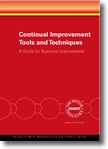 |
A histogram is a type of bar chart, used predominantly
for continuous variables. Histograms can be used to depict how measurements
vary from the mean value and can help to identify the cause of problems
in a process by the shape of the distribution as well as the width (deviation)
of the distribution.
The main difference
between a histogram and a bar chart is that the frequency in a bar
chart is represented by the height of the bar, whereas for a histogram
the frequency is represented by the area of the bar.
How to
- Histogram
The guide includes an overview of histograms, constructing a histogram,
interpreting histograms; as well as exercises for
getting started...
The
US Navy Total Quality Leadership Office
|
A Guide for Business Improvement
|
|


View larger image |
This guide explains how to carry out
more than twenty tools & techniques necessary to ensure your
business continually improves.
Topics covered include:
Affinity diagrams, Bar charts, Black & white charts, Brainstorming,
Cause & effect diagrams, Design of Experiments (DoE), Failure
Mode, Effect and Criticality Analysis (FMEA/FMECA), Fault Tree Analysis
(FTA), Five WHY’s for root cause analysis, Five Ws & one
H for problem definition, Flow charting, Histograms,
Pareto analysis, Pictograms, Pie charts, Plan-Do-Check-Act (PDCA)
cycle, Quality Function Deployment (QFD), Rating, Repeatability
and Reproducibility tests (R&R), Run charts, Significance testing,
Solution effect diagrams
Also includes a handy matrix showing when to apply which tool &
technique. |
| |
| Further reading |

|
The Memory
Jogger II: A Pocket Guide of Tools for Continuous Improvement
Michael Brassard |
| This
handy Pocket Guide uses graphics and easy-to-understand text to
describe what the tools are, why they’re used, and how to
use them. Tools are explained using real-life examples from all
types of organisations, making them easy for everyone to understand
and apply. The 22 Tools covered are
Activity Network Diagram, Affinity Diagram, Brainstorming, Cause
& Effect (Fishbone), Check Sheets, Control Charts, Data Points,
Flowchart, Force Field Analysis, Histograms, Interrelationship Digraph
(ID), Matrix Diagram, Multivoting, Pareto Chart, Prioritization
Matrices, Problem Solving Model, Process Capability, Radar Chart,
Run Chart, Scatter Diagram, Team Guidelines, Tree Diagram, Process
Decision, Program Chart, Nominal Group Technique (NGT).
|
| Buy
UK |
Buy
US |
|

top of page |
 |
